Integrating Carbon-Free Generation in the Carolinas
NREL and Duke Energy Investigate the Pathways to a Decarbonized Grid
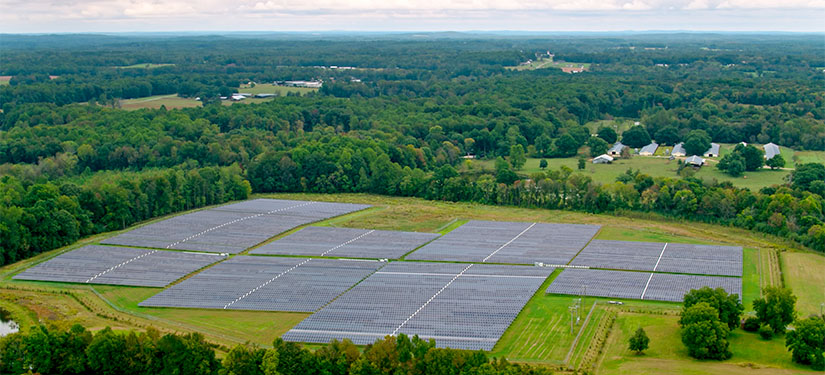
Like many utilities, Duke Energy is looking for opportunities to reduce carbon emissions in coordination with policymakers and regulators. In 2021, North Carolina passed legislation codifying a 70% emissions-reduction target for 2030 and a net-zero carbon dioxide emissions target for 2050, with Duke Energy also establishing its own goal of a net-zero CO2 emissions power system by 2050.
Achieving these targets while providing reliable and affordable power in the Carolinas is a central focus for Duke Energy's long-term planning. To support this transition, the National Renewable Energy Laboratory (NREL) has engaged in a multiyear project with Duke Energy that identified least-cost pathways for carbon-free power in the region. Although specific to Duke Energy's system, this Carbon-Free Resource Integration Study offers a modeling approach that can be customized for any utilities' carbon-free resource planning, using a variety of accessible NREL tools.
Planning Tools for Renewable Power Systems
NREL's project with Duke Energy included two phases. In Phase 1, the researchers conducted a preliminary analysis of adding substantial new solar energy to the system, in which they ratcheted solar output up to 30% of annual generation—leading to an 80% carbon-free system when considering output from wind, nuclear, and hydro—showing how solar curtailment ramps up as more is added to the system in future deployment scenarios. Read the full Phase 1 report to learn more.
The recently completed Phase 2 analysis provided a deeper analysis into the potential investments, costs, and effects on operations as Duke Energy integrates carbon-free energy. In this phase, NREL deployed a suite of planning tools to evaluate scenarios representing Duke Energy in both the near term (2030) and long term (2050). NREL released its Phase 2 report this week, which is the subject of the rest of this news article.
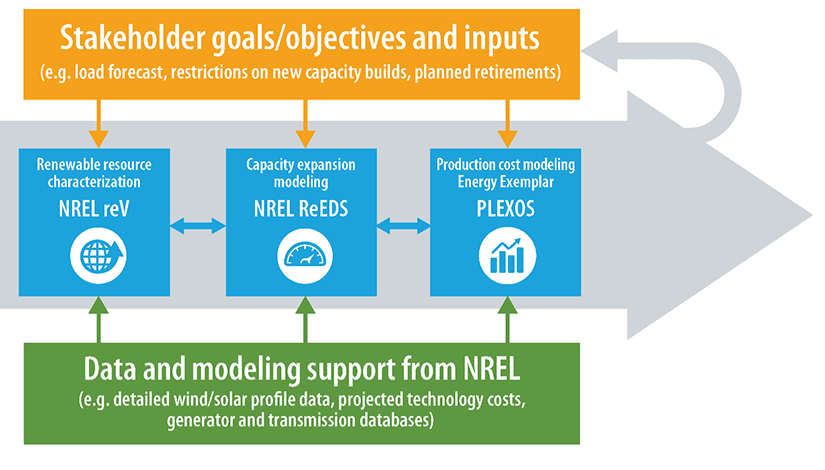
The NREL researchers began with high-resolution maps of the Carolinas’ wind and solar resource. This resource assessment includes hourly resource profiles and removes areas that would not be suitable for development. By plugging these maps into NREL’s open-source Renewable Energy Potential model, the researchers identified developable wind and solar sites in the Carolinas.
NREL then narrowed down Duke’s potential sites for wind and solar to locations that meet key system and decarbonization requirements. For this step, NREL used its Regional Energy Deployment System (ReEDS) capacity expansion model to determine the least-cost resource mix and to identify new transmission scenarios that satisfy critical power system requirements.
For a final validation step, NREL researchers tested the ReEDS resource mix on a full transmission model of the Carolinas using the commercially available PLEXOS software. NREL simulated the proposed buildouts at an hourly resolution, observing how each possibility would play out over one year of operation.
Simulation Results: Gigawatts of New Solar, Wind, and Storage
The figure below depicts the generation capacity deployed by ReEDS under a reference case (base) and with the emissions reduction targets of a 70% reduction in North Carolina by 2030 and zero-carbon emissions in 2050 (policy). The policy case also includes a “no fossil” scenario in which all fossil units in both Carolinas must be retired by 2050, including units not in Duke Energy’s service territory.
For its 2030 goals, ReEDS estimates that Duke Energy can meet its 70% target by retiring coal and investing in solar, battery storage, and wind. Although investments in offshore wind and an expansion of existing pumped hydro storage come after 2030, ReEDS does not consider all the logistical constraints for deploying new energy sources, making it important to advance these resources today given the time needed to build and integrate new generation resources.
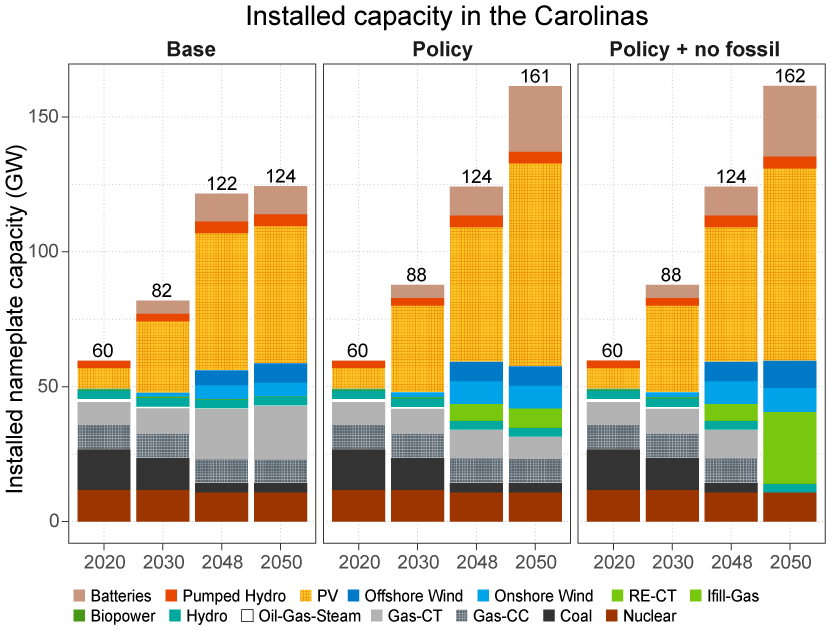
In NREL's scenarios, some of the retired coal units are replaced by natural gas generation. This substitution reduces CO2 emissions overall but increases methane emissions from pipeline leakage. Although pipeline leakage is not calculated in North Carolina's 2030 policy target, NREL measured methane emissions in the scenario analysis, as illustrated in the figure below. Furthermore, emissions can vary depending on the conditions of the system, with lower emissions associated with the planned coal retirements and higher emissions associated with a scenario simulating a more extended winter cold snap.
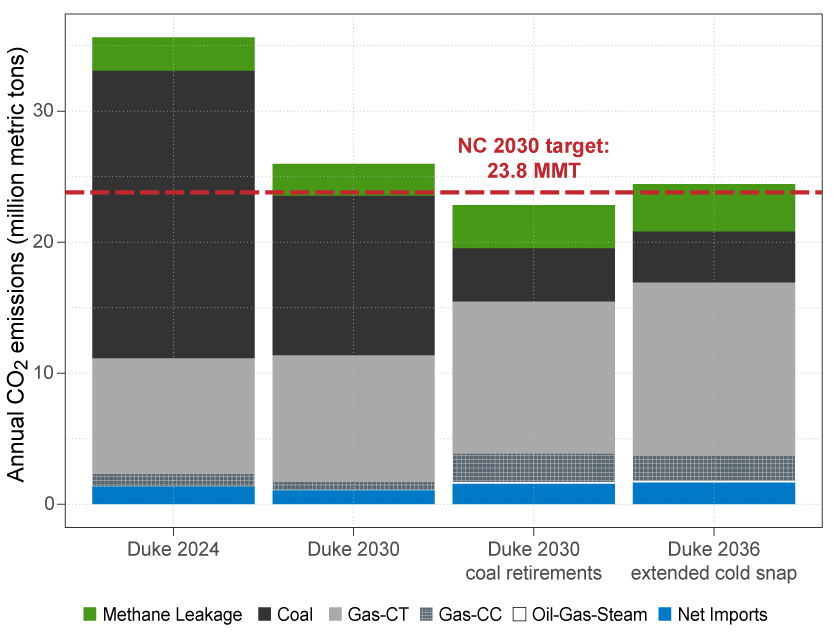
The difference in emissions based on weather shows the importance of evaluating system operations not only for "typical" weather, but also for more extreme conditions that might stress the system. In the "2036 extended cold snap" scenario, NREL tested the 2036 system buildout against weather data from 2018, a year in which Duke Energy experienced an extended winter peak load event. This cold snap is especially clear in the figure below, in which fuel consumption spikes substantially in the winter months.
"The 2036 extended cold snap modeling is particularly helpful in illustrating the need for technologies that can supply sustained power through challenging winter weather periods," said Mark Oliver, vice president of Integrated System Planning at Duke Energy.
Despite significant amounts of solar PV, wind, and 4-hour duration batteries, replacing Duke Energy's coal plants means finding technologies that can provide energy throughout a multiday winter peak when solar resource is less available and recharging batteries may be difficult. Oliver said that "although natural gas is available to serve this need until better alternatives are available, this could be replaced by hydrogen or renewable biofuels as Duke Energy moves to zero carbon emissions in the future".
A graph of daily gas offtakes for each of the scenarios analyzed. The 2036 cold front reveals a dramatic increase in fuel consumption, affecting how Duke can factor in a similarly strong winter for future planning.
Carbon-Free in 2050
The results for 2050 show a diverse system that is generally solar-dominant, smoothed out by storage, and supplemented by nuclear and wind. In the no-fossil case, renewable energy combustion turbines (RE-CTs) serve to provide peaking power toward both the summer and winter peaks. These turbines operate infrequently but are critical for providing power during key moments of high grid stress.
"Having generation resources that can provide energy when called upon during a few critical time periods of the year, when the system is stressed, provides a great deal of value," said Brian Sergi, NREL grid analyst and co-author of the study. Sergi noted that deploying generation technology that operates relatively infrequently but is available at key moments is consistent with other studies looking at the challenges of achieving deep decarbonization, including NREL's recent LA100 analysis exploring pathways to a zero-carbon system for the city of Los Angeles. Although modeled as RE-CTs in this study, this niche could be filled by a range of technologies such as seasonal storage and/or operational strategies like increased imports through coordination with neighbors.
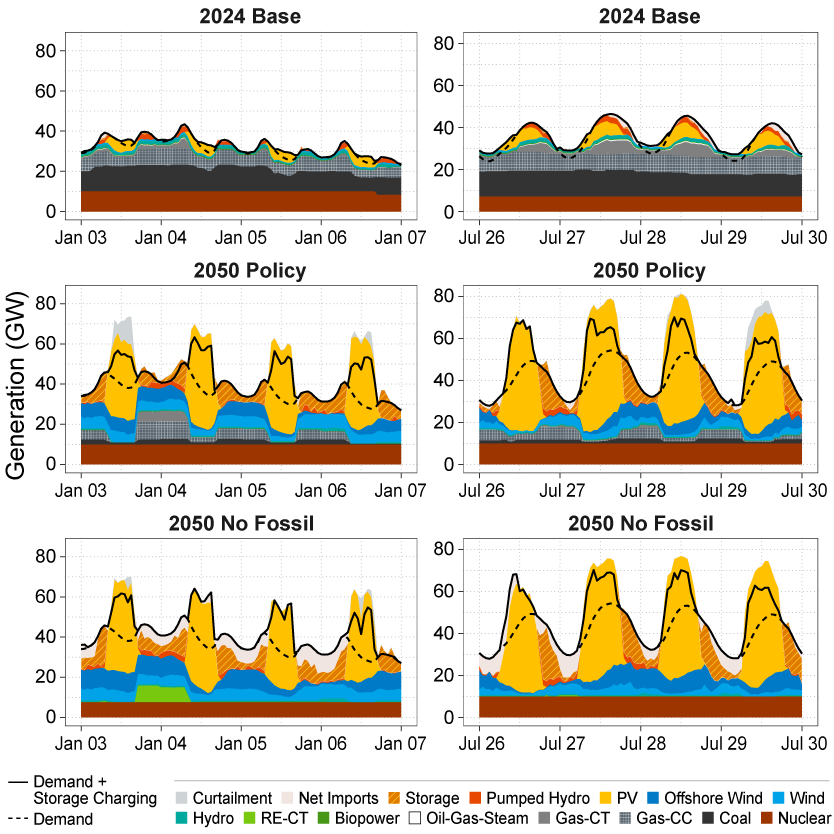
The pathway to achieving the zero-carbon target can affect the optimal mix of resources and how they are operated. For example, the no-fossil scenario shows less curtailment due to a greater deployment of storage and a greater reliance on net imports to make up for less natural-gas-based generation, albeit at a higher total cost than the policy case itself. Likewise, pathways in which neighboring utilities also pursue zero-carbon targets reduces opportunities to export otherwise curtailed power, increasing the value of deploying energy storage in the Carolinas.
The study also shows increasing opportunity for interchange with neighboring grids to support balancing supply and demand for the increasingly dynamic system with higher levels of renewable integration. A wide range of sensitivities demonstrate transmission upgrades and builds both within Duke Energy's service territory in the Carolinas and with neighboring power systems, illustrating the robustness of the value of these investments in high renewable outcomes.
An Example for Others
The analysis conducted here identifies a range of pathways for integrating carbon-free resources in the Carolinas. The NREL analysis does not supplant the traditional integrated resource planning effort run by Duke Energy, but it provides additional insight into the challenges and opportunities for achieving a carbon-free system.
The study focused on system buildouts that could meet the emissions reduction targets at least cost primarily from an operational perspective, and accordingly there are additional questions to explore on the path to zero emissions. For example, the projected capacity additions from the ReEDS modeling do not reflect logistical constraints such as speed of interconnection, supply chains, or other limitations that can constrain the actual pace of renewable integration. Realizing the emissions reductions targeted by policymakers and Duke Energy will thus require continued research to understand the challenges and opportunities ahead.
Despite being tailored for the Carolinas, this study can help inform decision-making of utilities, grid operators, and policymakers that are planning for clean energy, not only in the Southeast, but across the country.
Follow NREL's work in energy analysis.
Last Updated May 28, 2025
